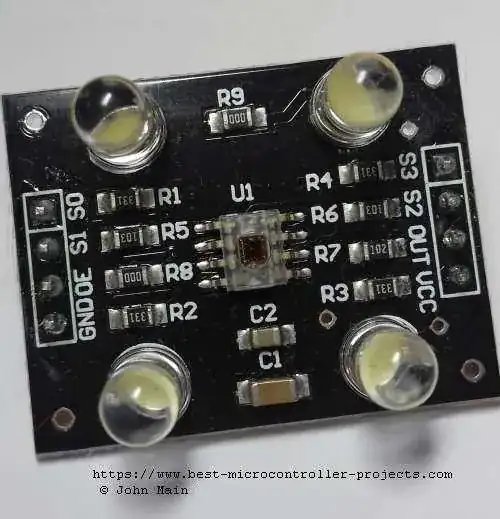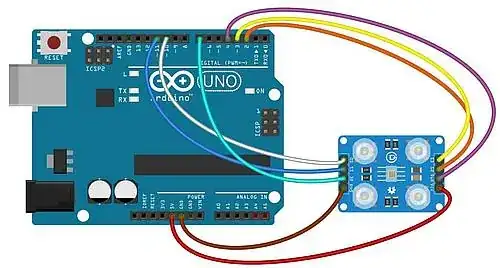Use a TCS230 photo sensor and a 6500K light source to color correct your objects.

This hookup will get you started

This sketch, courtesy of Best-Microcontroller-Projects will get you going. Read the tutorial and dont forget to calibrate.
//
// Detect colors using TCS230.
//
// Arduino uno pins for control of TCS230
#define TCS320_OE 7
#define TCS320_S0 10
#define TCS320_S1 11
#define TCS320_S2 2
#define TCS320_S3 3
#define TCS320_OUT 4
#define variance 50 // Acceptable detection error 2%.
#define SEL_RED \
digitalWrite(TCS320_S2,LOW);digitalWrite(TCS320_S3,LOW)
#define SEL_GREEN \
digitalWrite(TCS320_S2,HIGH);digitalWrite(TCS320_S3,HIGH)
#define SEL_BLUE \
digitalWrite(TCS320_S2,LOW);digitalWrite(TCS320_S3,HIGH)
#define SEL_CLEAR \
digitalWrite(TCS320_S2,HIGH);digitalWrite(TCS320_S3,LOW)
#define TWO_PER \
digitalWrite(TCS320_S0,LOW);digitalWrite(TCS320_S1,HIGH);
#define debug(a) Serial.println((a));
#define NUMCOL 5
// int RGB[NUMCOL][3]; // Five colors with 3 elements.
// Array of NUMCOL strings len 10. 11 for null.
// char colname[NUMCOL][11];
// Typical values for 2% dividers (set variance to 50).
int RGB[NUMCOL][3]={
{248,647,393},
{188,261,265},
{404,710,546},
{506,493,304},
{930,1199,837},
};
char colname[NUMCOL][11]={
"red",
"yellow",
"brown",
"blue",
"black",
};
////////////////////////////////////////////////////////////////
void setup() {
pinMode(TCS320_OE,OUTPUT);
pinMode(TCS320_S0,OUTPUT);
pinMode(TCS320_S1,OUTPUT);
pinMode(TCS320_S2,OUTPUT);
pinMode(TCS320_S3,OUTPUT);
pinMode(TCS320_OUT,INPUT);
TWO_PER;
digitalWrite(TCS320_OE,LOW); // On always.
Serial.begin(115200);
Serial.println("TCS230 color detector");
}
////////////////////////////////////////////////////////////////
unsigned long get_TCS230_reading(void) {
unsigned long val;
noInterrupts();
val = pulseIn(TCS320_OUT,HIGH,20000); // 2000us=2ms 2Hz min.
interrupts();
return val;
}
static int clr,red,green,blue;
////////////////////////////////////////////////////////////////
uint16_t detect(void) {
unsigned long val;
SEL_RED;
red = val = get_TCS230_reading();
Serial.print("RED: "); Serial.print(val);
SEL_GREEN;
green = val = get_TCS230_reading();
Serial.print(" GREEN: "); Serial.print(val);
SEL_BLUE;
blue = val = get_TCS230_reading();
Serial.print(" BLUE: "); Serial.print(val);
Serial.print(" \n");
}
////////////////////////////////////////////////////////////////
int withinEQ(int c, int xl, int xh) {
if (c>=xl && c<=xh) return 1;
return 0;
}
////////////////////////////////////////////////////////////////
// Compare a value to a value and variance.
int compare(int c, int v, int err) {
int xh=v+err, xl=v-err;
if (withinEQ(c,xl,xh)) return 1;
return 0;
}
////////////////////////////////////////////////////////////////
void loop() {
uint8_t chr,i,fnd;
if (Serial.available()>0) {
chr = Serial.read(); // Consume.
// Find color match.
detect();
fnd=0;
for (i=0;i<NUMCOL;i++) {
if ( compare(red,RGB[i][0],variance) &&
compare(green,RGB[i][1],variance) &&
compare(blue,RGB[i][2],variance)
) { // Found
Serial.print("Col is :");
Serial.println(colname[i]);
fnd=1;
break;
}
}
if (!fnd) Serial.println("NOT Found");
}
}

